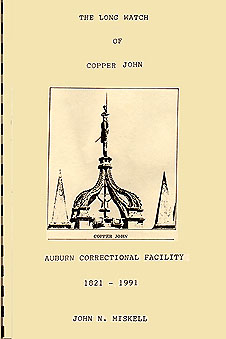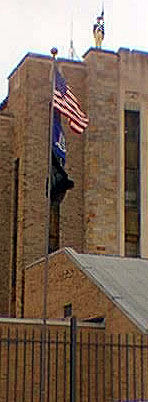 | (NYCHS © 2003 photo)
|  |
 | (NYCHS © 2003 photo)
|  |
One of the first things that a visitor to Auburn notices when approaching Auburn Correctional Facility is the commanding figure of a Continental soldier towering above the roof of the main prison building facing State Street. The visitor might well wonder when the statue was placed on the roof, who put it up there, and why is it up there at all? What special significance, if any, does its presence have for inmates, employees, and/or the citizens of the City of Auburn? Upon inquiry the visitor will be informed by nearly every local citizen that he or she is looking at the statue known far and wide as "Copper John" and that the statue is nearly as old as the prison itself. Further in-depth inquiries may go unanswered; for, while much has been written about "Copper John" over the years, some basic questions are still wrapped in mystery. However, a review of available literature containing references to the statue provides answers to the who, where, when and possibly the why of its existance and permanent prominent position. According to an article in Correction magazine, an official publication of the New York State Department of Correction, the figure of "Copper John" was placed on the peak of the original administration building in 1821, while the building was still under construction. This building wasn't fully operational until 1823. Constructed of Onondaga limestone quaried locally, the edifice, designed for durability and security, was massiver grim and aesthetically unappealing without ornamentation of any kind. The architect, perhaps in an attempt to soften the appearance of the fortress-like front entrance, erected a distinctive, rather ornate bell tower on top of the administration building. The bell was to be rung to alert the citizens of Auburn when trouble occurred inside or when an escape attempt was made from the prison. Placing the statue of a Continental soldier above the -belfry, "On Duty," standing at attention, a symbol,of a firm and resolute staff prepared to protect citizens from the depredations of persons who had violated the law, was an inspiration that met with the approval of all Auburnians. It made sense to them that a group of prison officials with a military background might decorate their institution with a soldier sentinel. Frank Avery Skilton, another historian, wrote this about the tall figure; "Historically his poise and his-toggery are not unlike those singular characteristics displayed by the soldier in rank of General Washington's "Life Guard," after whom he was probably patterned. . . .This military organization was made of men selected for their unqualified patriotism, fidelity, courage, fearlessness and superior qualities of physical endurance - men who had been tried out and not found wanting. Records show that four men in Washington's "Life Guard" were granted land in the military tract of Central New York where the City of Auburn is located today. The article in Corrections magazine continues: ... the figure of the Continental soldier at Auburn had become so decayed and worm eaten that in 1848 it was taken down and a replica was hammered out of sheet copper by convict labor in the foundry maintained at the prison. John Gaylord was the foundry superintendent. Because of its construction of copper, the new soldier became known as,,, Copper John." Over the years many persons have wondered who "John" was. In a recent news story, Dick Case, Columnist, Syracuse Herald Journal, tried to identify "John". He gathered information on four persons who were distinct possibilities:
Unfortunately there isn't
enough information available today to pinpoint any one person.
However, after similar research in 1922, Frank Avery Skilton ventured a guess, and as he wrote, "It's only a guess that 'Copper John' received his baptismal name in honor of his artisan creator ... John D. Cray." Not much information is available on Cray. He served as deputy keeper under Elam Lynds, Agent and Warden of Auburn Prison from 1821-1829. W. David Lewis credits John D. Cray ". . . as the man who devised most of the elaborate techniques which were necessary to maintain the silent system, such as the lockstep, various seating and working arrangements, and the undeviating routine which inmates followed from dawn to dark." Cray resigned in 1823 when he found his position working under Lynds too difficult to endure. Lynds would not allow Cray to open a school for illiterate convicts, something he believed in. Over the years "Copper John" became one of the widest known natives of Auburn, especially in the criminal world. He even outlasted the building that he stood on; the administration-building finally fell into decay and the Legislature provided funds for the construction of a new building. When the structure was razed in 1938 the historic bell tower and the statue of "Copper John" came down. There was much speculation among the residents of Auburn as to the future of the weather beaten soldier. Under the caption "Copper John in Jeopardy," the Auburn Citizen-Advertiser commented editorially: What, is there danger that Copper John may be demobilized? That he may be relieved of a sentinel duty which he has discharged so faithfully and patiently? Can a mere decision to substitute a modern structure for the old prison building atop which Ole John has kept watch these 90 years shelve a figure which has become an integral part of the ancient bastille? Copper John is probably the least forbidding thing about Auburn Prison. His vigilence has nothing in it of malevolence; rather it is the spirit of the Continental soldier beneath whose rough exterior beats a heart of pure copper. . . . What if Copper John is given to brooding at times? So would you, if you had witnessed what he has. . . . . Copper John has heard shots and seen men dash for liberty. He has known what violence can be when hope is gone, when the germ of revolt gets in the air and spreads contagion through the galleries. Do not wrench him from his place! To those Vho have not seen him day to day through the years he may be only an architectural doo-dad, a meaningless puppet stuck on an eminence; but for others he symbolizes the story of penology. Without him Auburn Prison will become . . . -- just another prison. Shortly after the above article was written, Commissioner Edward P. Mulrooney indicated that "Copper John will take his place on top of the new structure, perhaps to remain for another century ..." During the period that "Copper John" was off duty, a kit of measuring devices was employed to take his Bertillon measurments. The old soldier weighs approximately 600 pounds. His skin is a quarter of an inch thick, and his boots are 14 inches long and 14'-2 inches high. To the tassel on top of his hat he stands eight feet, eight and a half inches. His rifle, weighing about 100 pounds, is slightly more than 11 feet over all, with its butt three feet, barrel five feet, and a bayonet measuring 31 inches. When the new administration building was completed, "Copper John" was decorated with a new coat of paint and then was hoisted to the top of the building to again stand vigil over the oldest prison in the state. Since returning to his post he has occasionally been fitted with a new suit of regimentals, and several times he has had to have his pants mended. Sometimes he takes in too much water and freezing, he rips his seams. The latest major repairs were made about ten years ago when his head became detached and the plume began to disintegrate. A work crew decapitated the statue and delivered the head to Edward Clancy, sheetmetal instructor in The Osborne School. Ed was able to rebuild the plume with its grouping of curled metal strips that gave the effect of feathers on the hats of the proud men who were members of Wasbington's "LifeGuard." A completely rejuvenated "Copper John" continues his lone sentry duty to this day. Auburnians have come to look upon him as a historic landmark, one without the city would not seem to be the same. John N. Miskell |
 |
|